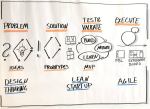“The Business Model Canvas is like a blueprint for your business – it provides a clear and concise overview of how your company creates, delivers, and captures value.”
Alexander Osterwalder, inventor of the Business Model Canvas.
Business Model Canvas is a strategic management and entrepreneurial tool that helps businesses to visually map and analyze their business model in a simple and concise way. It was first proposed by Alexander Osterwalder and Yves Pigneur in their book “Business Model Generation.”
The objective of the Business Model Canvas is to provide a visual and strategic tool for entrepreneurs and businesses to map out and analyze their business model in a clear and concise manner. It is a one-page framework that helps businesses to understand, design, and communicate their business model, which is the way in which a company creates, delivers, and captures value.
Building Blocks Of Business Model Canvas
The Business Model Canvas consists of nine key building blocks that form the foundation of a business model. By using the Business Model Canvas, businesses can better understand how these elements work together to create a successful and sustainable business model.

These building blocks are:
1. Customer Segments: This block defines the different groups of people or organizations a business aims to serve. It helps to identify the needs and wants of each segment and tailor products and services accordingly.
2. Value Proposition: This block describes the products or services a business offers to its customers and how it solves their problems or satisfies their needs. It defines the unique value a business brings to the market and differentiates it from its competitors.
3. Channels: This block represents the various ways a business delivers its value proposition to its customers. It includes the communication, distribution, and sales channels used to reach customers.
4. Customer Relationships: This block describes the type of relationship a business has with its customers. It outlines how a business interacts with its customers, how it acquires and retains them, and how it creates customer loyalty.
5. Revenue Streams: This block defines the sources of revenue for a business. It includes the pricing models used, the payment methods accepted, and the revenue streams generated from each customer segment.
6. Key Resources: This block describes the critical resources a business needs to deliver its value proposition. It includes physical, intellectual, human, and financial resources required to operate a business.
7. Key Activities: This block represents the primary actions a business needs to take to deliver its value proposition. It includes the activities necessary to produce, market, sell, and support products and services.
8. Key Partnerships: This block describes the strategic alliances a business forms with other companies to enhance its capabilities or reduce risks. It includes the relationships with suppliers, distributors, co-creators, and other key partners.
9. Cost Structure: This block defines the costs associated with delivering a business’s value proposition. It includes the fixed and variable costs, economies of scale, and cost drivers for each key activity and resource.
By filling out each of these building blocks, a business can create a comprehensive and structured overview of its business model. This can help the business to identify areas for improvement, as well as potential risks and opportunities. The canvas can also be used to test new business ideas and to communicate the business model to others, such as investors, employees, and partners.
🅐🅚🅖
Interested in Management, Design or Technology Consulting, contact anil.kg.26@gmail.com
Get updates and news on our social channels!
LATEST POSTS
- A Tale Of Two Frameworks: Spring Boot vs. Django
 “Spring Boot’s convention over configuration approach simplifies development, allowing developers… Read more: A Tale Of Two Frameworks: Spring Boot vs. Django
“Spring Boot’s convention over configuration approach simplifies development, allowing developers… Read more: A Tale Of Two Frameworks: Spring Boot vs. Django - Unleashing The Power Of Django
 “Django, akin to a Swiss Army knife, provides a comprehensive… Read more: Unleashing The Power Of Django
“Django, akin to a Swiss Army knife, provides a comprehensive… Read more: Unleashing The Power Of Django - Potential of Progressive Web Apps (PWAs)
 “PWAs are not just about technology; they are about creating… Read more: Potential of Progressive Web Apps (PWAs)
“PWAs are not just about technology; they are about creating… Read more: Potential of Progressive Web Apps (PWAs) - Unleashing The Power Of Spring Framework
 “Spring Framework simplifies enterprise Java development, but it does so… Read more: Unleashing The Power Of Spring Framework
“Spring Framework simplifies enterprise Java development, but it does so… Read more: Unleashing The Power Of Spring Framework - Key Trends Of OSINT In 2024
 “The future of OSINT lies in our ability to adapt… Read more: Key Trends Of OSINT In 2024
“The future of OSINT lies in our ability to adapt… Read more: Key Trends Of OSINT In 2024 - Can Google’s Carbon Language Replace C++?
 “While Carbon may excel in performance-critical domains, it cannot replace… Read more: Can Google’s Carbon Language Replace C++?
“While Carbon may excel in performance-critical domains, it cannot replace… Read more: Can Google’s Carbon Language Replace C++? - Integration of Design Thinking, Lean, and Agile
 “Innovation thrives when Design Thinking, Lean, and Agile converge, creating… Read more: Integration of Design Thinking, Lean, and Agile
“Innovation thrives when Design Thinking, Lean, and Agile converge, creating… Read more: Integration of Design Thinking, Lean, and Agile - Benefits Of Infrastructure as Code (IaC)
 “Infrastructure as Code is the single most important thing you… Read more: Benefits Of Infrastructure as Code (IaC)
“Infrastructure as Code is the single most important thing you… Read more: Benefits Of Infrastructure as Code (IaC) - Power Of Internet of Everything (IoE)
 “The true power of the Intebrnet of Everything lies not… Read more: Power Of Internet of Everything (IoE)
“The true power of the Intebrnet of Everything lies not… Read more: Power Of Internet of Everything (IoE) - How Is The Enterprise IoT Evolving?
 “IoT is not just about connecting things; it’s about connecting… Read more: How Is The Enterprise IoT Evolving?
“IoT is not just about connecting things; it’s about connecting… Read more: How Is The Enterprise IoT Evolving? - IT Pricing Strategy And Models
 “The art of pricing lies in finding the perfect balance… Read more: IT Pricing Strategy And Models
“The art of pricing lies in finding the perfect balance… Read more: IT Pricing Strategy And Models - What Is SYCL (“sickle”)?
 “SYCL provides a powerful and intuitive programming model that simplifies… Read more: What Is SYCL (“sickle”)?
“SYCL provides a powerful and intuitive programming model that simplifies… Read more: What Is SYCL (“sickle”)? - What Is A Data Lakehouse?
 “With a data lakehouse, organizations can break down data silos,… Read more: What Is A Data Lakehouse?
“With a data lakehouse, organizations can break down data silos,… Read more: What Is A Data Lakehouse? - 5G – The Future Of The Internet
 “5G is the next big step in the evolution of… Read more: 5G – The Future Of The Internet
“5G is the next big step in the evolution of… Read more: 5G – The Future Of The Internet - Ransomware Groups Are Switching To Rust
 “Rust is to Ransomware what a lockpick is to a… Read more: Ransomware Groups Are Switching To Rust
“Rust is to Ransomware what a lockpick is to a… Read more: Ransomware Groups Are Switching To Rust - Streaming Data Pipelines
 “A streaming data pipeline is like a river: it flows… Read more: Streaming Data Pipelines
“A streaming data pipeline is like a river: it flows… Read more: Streaming Data Pipelines - Why Rust Is Best?
 “Rust is a systems programming language that runs blazingly fast,… Read more: Why Rust Is Best?
“Rust is a systems programming language that runs blazingly fast,… Read more: Why Rust Is Best? - Database Sharding Explained
 “Database sharding is like breaking a large puzzle into smaller,… Read more: Database Sharding Explained
“Database sharding is like breaking a large puzzle into smaller,… Read more: Database Sharding Explained - Ambient Computing Will Be The Future Tech
 “Ambient computing creates a seamless technology-rich environment, but challenges in… Read more: Ambient Computing Will Be The Future Tech
“Ambient computing creates a seamless technology-rich environment, but challenges in… Read more: Ambient Computing Will Be The Future Tech - Key Trends Of OSINT In 2023
 “OSINT is not just a technique, it’s a mindset. It’s… Read more: Key Trends Of OSINT In 2023
“OSINT is not just a technique, it’s a mindset. It’s… Read more: Key Trends Of OSINT In 2023

